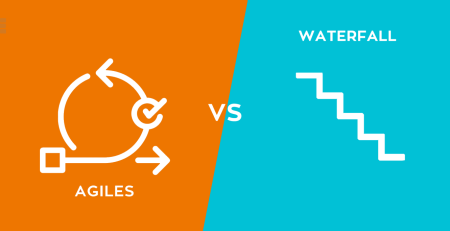Getting Started With Mobile Application Architecture
High competitiveness motivates businesses to constantly improve their services, making them more convenient, faster, and easier to access. Building a mobile application is one of the most effective ways to increase brand awareness and gain a desired position in customers’ mobile devices.
According to Statista, there are 3.5 billion mobile phone users worldwide in 2020, with the figure expected to rise to 3.8 billion by 2021, with 90% of their mobile time spent on mobile apps. All of these factors are expected to have a positive impact on the global app market, which is expected to generate $693 billion in 2021 and $935.2 billion in 2023. As a result, developing a robust and appealing mobile app is a sure way to gain and retain more customers while increasing your company’s revenue.
However, in order to create a successful app, you need more than just an appealing UI design. It should be easy to use, fast, secure, well-structured, and free of fatal or critical errors. In short, you must create a well-thought-out mobile application architecture.
What Is Mobile App Architecture?
A mobile architecture is a set of rules, techniques, and patterns that describe how to create a mobile application. This set enables the creation of logical and well-structured apps that meet the needs of customers and industry standards. Let’s take a closer look at how it functions.
Many factors influence the development of a good mobile architecture, including the type of mobile platform, device, internet connection speed, potential mobile gadget characteristics – CPU load, screen size, resolution, and many others.
Before beginning to build an app, a team of experts should define the customer’s requirements and break them down into small logical chunks for mobile developers to code.
Once the team has decided which features to include in the app, they create the app architecture, which is a skeleton that connects these features into a single app. The productivity, scalability, and user-friendliness of an app are all affected by how thoroughly the development architecture is thought out.
What Makes a Good Mobile App Architecture
When creating a mobile app architecture, software developers have to follow a number of principles such as:
- SOLID – 5 principles of object-oriented programming for building easy to maintain and scalable apps,
- KISS – a principle of keeping the system and code simple to minimize the number of errors,
- DRY – a principle of reducing repetition in software patterns to avoid redundancy, and other principles.
Furthermore, when developing a mobile app, software developers should priorities Clean architecture. This architecture type denotes that each app layer is independent of any external programs or layers. When transitioning between layers, software developers use the Dependency Rule to connect independent layers. Boundaries are the Input and Output ports that allow data to be transferred between layers.
The Clean mobile app architecture is universal, allowing software developers to easily add multiple plug-ins to the app, perform quick troubleshooting and unit tests, and scale the app. As a result, it speeds up mobile app development and significantly reduces costs.
Another factor to consider when designing an app architecture is the app’s mobile platform (Android or iOS), as these platforms will necessitate different development technologies.
Swift, Objective-C programming languages and iOS SDK, XCode, AppCode development tools are commonly used by iOS software developers, whereas Kotlin, Java, C/C++ programming languages and Android SDK, Eclipse, Android Studio, and other tools are commonly used by Android software developers. When it comes to developing complex app features required by any business, these programming languages and tools are the most effective.
The Multiple Layers of Mobile App Architecture Design
Each mobile application has its own set of layers. Three-layer architecture is the most common layer pattern. It is made up of three layers: the presentation layer, the business layer, and the data layer.
Presentation layer
The presentation layer is responsible for delivering and representing data to the user. It is essentially what a user sees and feels when interacting with the app. Software developers pay close attention to User Interface (UI) and User Experience (UX) designs when creating the presentation layer. Fonts, themes, colors, app navigation intuitiveness, what peripherals your app can connect to, and other visual components are included in UX/UI design.
Business layer
The business layer is in charge of data exchange and processing operations. Your app represents various tasks at this layer, such as data validation, data caching, logging, exception management, and others. Aside from that, the business layer creates business rules, executes complex business procedures, and manages workflow.
Depending on the number of operations your app performs and the number of resources available on a user’s device, this layer can be deployed on the backend server or on the user’s device.
Data layer
The data layer is in charge of data security and maintenance. It is made up of data access elements, service tools, and utilities. When designing this layer, software developers should keep in mind how it will scale as business requirements change in the future. It is also critical to select the appropriate data access and validation technology to ensure that this layer is secure from invalid data input and functions properly.
Tips on How to Choose the Right Architecture for Your Mobile App
The choice of the right mobile application depends on its target audience, platforms it’ll be deployed on, features and functionality you plan to include in the app, time and money you’re ready to spend on app development, and the skills of your development team.
There are three main app types that define app architecture:
- native apps;
- hybrid apps;
- mobile web apps.
Native apps
Native mobile apps are stored and run on a device’s local storage. These apps are similar to built-in apps like web browsers or email, and they can access all of a mobile device’s features and APIs. The app stores have a large selection of native apps.
Native apps are developed for a specific mobile platform using specific programming languages and frameworks. To build an Android app, for example, you’ll need Java and Android Studio. As a result, if you want to run the same app on the iOS platform, you must create a new app from scratch using iOS-specific tools such as Swift and AppCode.
Native apps are quick, work offline, are easy to use, and run smoothly on compatible devices. However, they require significant time and money to develop, require frequent upgrades, and are not flexible because you will have to develop a new app if you decide to explore other mobile app platforms.
Android Mobile Application Architecture
There is no such thing as a single mobile architecture for Android, and Google provides no architecture documentation or guidelines. Nonetheless, the Android development community has concluded through trial and error that the Clean architecture works best for Android apps.
The separation of architecture layers is what makes Clean architecture so effective for Android app development. It makes layers independent while still allowing them to exchange data.
The Clean architecture is usually represented as a circle of four layers:
- Entities – a business logic;
- Use Cases/Unteractors – app logic;
- Interface Adapters – the adapters that convert data from the use cases format to the external agency format such as Database or Web; Interface adapters include Presenters Controllers, and Gateways;
- Frameworks and Drivers – is the outer layer composed of frameworks and tools, e.g. The Databases, UI, http-client, and others.
To maintain the Dependency Rule, each layer has its own Boundaries when the business logic and app logic do not rely on Presenters, UIs, or Databases. These Boundaries enable communication between layers by providing two interfaces: an output port for the answer and an input port for the request.
Clean Architecture is distinguished by its explicit structure and layer independence:
- simple to test and troubleshoot;
- independent from UI;
- independent from databases, external frameworks, and libraries;
- easy to install various plug-ins.
iOS Mobile App Architecture
Unlike Android, the Apple system provides more guidance to software developers on how to create iOS mobile architecture based on the MVC model (Model-View-Controller). However, iOS developers are not limited to just one architectural pattern; this is the one that is most commonly used in iOS apps.
The MVC model consists of three layers:
- Model – is a layer that holds all the data, including persistence, model objects, parsers, managers, and networking code;
- View – is responsible for visual representation; this is the layer that interacts with the users and doesn’t have any domain-specific logic, therefore, the classes in this layer are reusable;
- Controller – is the layer that mediates interaction between the view and the model.
The MVC operating principle is straightforward. The user interacts with the iOS app and performs a view layer action. The action is passed to the controller by the view. The controller examines the action received and makes some decisions. If necessary, it can navigate to Model and make changes there. The model modifies data values and returns them to the controller. The controller then passes the values to the view, which displays the results to the user.
iOS developers can use the MVC model to:
- Significantly accelerate mobile app development process;
- Develop transparent communication between app layers;
- Get a well-structured, simple-to-maintain codebase;
- Get a simple-to-test codebase.
Hybrid apps
Hybrid apps are an alternative to native apps that only work on one platform. For their development, these solutions make use of web technologies. They run inside native apps and display web-based content within the native app wrapper. Their content can be embedded in the app or accessed via a web server. As a result, these web-based apps have access to a device’s hardware while combining web and native screens. These apps are also available in app stores.
Hybrid apps are typically less expensive and faster to develop than native apps, and they can make use of native APIs such as contacts, cameras, and so on. They have a single codebase for Android and iOS apps, so you don’t have to create two apps from scratch for each platform. Hybrid apps require less maintenance than native apps.
Downsized apps have connection limitations, cannot work offline, and are much slower than native apps. It may be difficult to achieve native functionality because your app cannot incorporate all of the device’s features. It’s difficult to maintain high and equal performance for both platforms because they require a lot of code changes, resulting in a worse user experience than native apps.
Hybrid Mobile Application Architecture
The main goal of software developers when creating hybrid mobile apps is to create an app with a single code base that is compatible with both the Android and iOS platforms. Software developers do this by combining native (Android/iOS) code with web code.
The following is a typical hybrid architecture. The presentation layer includes a web-based interface. It’s made with web technologies like HTML, CSS, and JavaScript, and it’s powered by the rendering engine. PhoneGap, Apache Cordova, and Ionic Capacitor are software development frameworks that communicate with the native part via API calls.
Mobile web apps
Mobile web apps are entirely web-based and can be accessed via a URL in a browser. Many mobile web app providers create icons that can be placed on a home screen and launched from there for added convenience. However, the app is not installed on the device, but rather saved on the screen.
These apps are created using HTML, JavaScript, and CSS technologies and are automatically updated from the web without the need for a submission process or vendor approval.
Because mobile web apps run in a browser, they are highly compatible with any platform and thus have a larger audience. They are simpler and less expensive to maintain because you only need to edit or change the content or design once, and the changes are reflected across all mobile platforms.
Mobile web apps, on the other hand, do not have access to native device features such as GPS, cameras, and so on. They may have issues with screen sizes, requiring software developers to make numerous adjustments. They can operate online, but only with limited functionality. All of this has a negative impact on the user experience.
Conclusion
The architecture of any mobile app is critical to its success. As a result, it is critical to carefully consider what features you intend to include in your app, how you intend to deploy them, and how they will be connected in the architectural layers.
Many factors influence the type of architecture, including the type of end-users, mobile platforms, and resources available. It can be difficult to consider all of these factors when developing your app. It’s a good idea to plan app development with a mobile app development company, which can advise you on the best architecture type to use and the most efficient ways to develop your app.













Leave a Reply